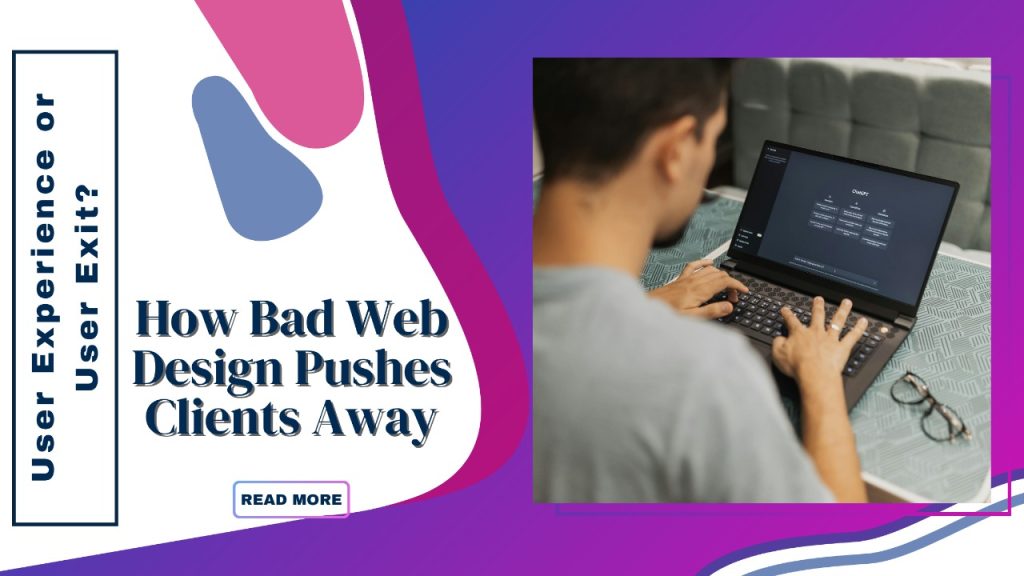When it comes to building trust online, your website is often the first impression potential clients have of your business. Unfortunately, common mistakes in web design can quickly turn that impression into frustration—leading visitors to exit before they ever become customers. From confusing navigation and slow load times to cluttered layouts and poor mobile optimization, even small errors can push clients away without you realizing it. In this post, we’ll explore how bad design choices impact user experience and what you can do to ensure your website attracts and retains the right audience.
Web design plays an essential role in shaping user experience. A well-crafted site not only attracts visitors but also keeps them engaged and encourages them to take action. On the flip side, bad web design drives users away faster than you can say “404 error.” Let’s explore the key elements of great web aesthetics and functionality, and uncover the common mistakes in web design that can drive your audience away before they even discover what your business has to offer!
Common Mistakes in Web Design that Push Users Away
Web design can make or break a user’s experience. Unfortunately, many websites fall victim to common mistakes in web design that deter potential customers.
One major issue is overwhelming users with cluttered layouts. A chaotic homepage can confuse visitors and lead them to leave faster than they arrived. Simplicity often wins the day.
Another prevalent error is using hard-to-read fonts or poor color combinations. If your text blends into the background or strains the eyes, users are likely to abandon ship in search of easier reading materials.
Moreover, neglecting mobile responsiveness can be detrimental. With more people browsing on smartphones, a website that isn’t optimized for mobile devices risks alienating a significant portion of its audience.
Ignoring accessibility features limits access for some users. Ensuring your site accommodates everyone fosters inclusivity while enhancing overall engagement and satisfaction among all visitors.
Slow Loading Times and Cluttered Layouts
Slow loading times can be a dealbreaker for website visitors. Research shows that users expect a site to load in just two seconds. If it takes longer, they’re likely to bounce.
A cluttered layout compounds this issue. When elements are crammed together, it creates visual chaos that overwhelms the user. Instead of guiding them through content, it pushes them away.
Visitors want clarity and speed. A clean design with ample white space allows users to focus on what matters. It enhances readability and makes navigation intuitive.
By optimizing images and minimizing unnecessary elements, you can significantly improve loading times while creating an aesthetically pleasing experience. Simplifying your website not only keeps users engaged but also encourages exploration rather than frustration.
Lack of Mobile Responsiveness
A lack of mobile responsiveness is a glaring flaw in today’s web design landscape. With the surge of smartphone users, a website that doesn’t adapt to smaller screens can severely limit its reach.
Imagine trying to navigate a site only to find text too small and buttons too cramped. Users quickly become frustrated and leave, opting for competitors with more accessible designs.
Mobile responsiveness isn’t just about fitting content on a screen; it’s about delivering an optimal experience regardless of device. When elements are misaligned or images slow to load on mobile, potential customers may abandon their search entirely.
Search engines notice these factors as well. Websites failing in mobile usability often see drops in rankings. Prioritizing responsive design is not merely beneficial—it’s essential for retaining visitors who expect seamless browsing experiences anywhere they go.
Poor Navigation and Confusing User Interface
Navigating a website should feel intuitive, but poor navigation can create frustration. Users expect to find information quickly and easily. When they encounter hidden menus or disorganized layouts, they often abandon the site.
A confusing user interface only adds to their woes. Icons that don’t match their function or labels that lack clarity lead to misunderstandings. Visitors may click around aimlessly, feeling lost in a digital maze.
Effective web design prioritizes user experience by streamlining navigation paths. Clear headings and logical structures guide users effortlessly from one section to another. Consistent placement of buttons also helps reinforce familiarity.
Websites need to speak the users’ language—this means using terms they’re familiar with rather than jargon that creates barriers. If visitors can’t figure out how to navigate your site, they’ll likely move on without hesitation, costing you potential clients.
Importance of Consistency in Branding and Design
Consistency in branding and design creates a cohesive identity. When users encounter your website, they should immediately recognize it as an extension of your brand. This recognition fosters trust.
A unified color palette enhances visual appeal. It keeps elements from feeling disjointed or chaotic, allowing visitors to focus on the content instead of being distracted by mismatched styles.
Fonts also play a crucial role. Using a consistent typeface ensures readability and strengthens brand recall. Users associate certain styles with specific feelings; choose wisely.
Imagery must align with your overall message too. High-quality visuals that mirror your brand values can leave lasting impressions on visitors.
Consistency across all platforms is vital. Whether users engage via desktop or mobile, they should experience seamless transitions that feel familiar and inviting. This alignment encourages engagement and loyalty over time.
The Impact of Bad Web Design on User Retention and Conversion Rates
Bad web design has a direct impact on user retention. When visitors encounter cluttered layouts or confusing interfaces, frustration sets in. This leads to quick exits, diminishing the chances of return visits.
Conversion rates suffer as well. A poorly designed website can derail even the best marketing campaigns. Users are less likely to complete purchases or sign up for newsletters if they struggle with navigation.
Trust plays a crucial role here too. An unprofessional appearance can raise doubts about credibility. If users feel uncertain about your site, they’ll seek alternatives elsewhere.
In an era where first impressions matter immensely, bad web design sends potential customers running in the opposite direction. Businesses must recognize that investing in quality design is not just aesthetic; it’s essential for keeping users engaged and driving conversions forward.
How to Improve Your Website’s Design for Better User Experience
Improving your website’s design starts with understanding your audience. Analyze their behavior and preferences to tailor the experience accordingly.
Streamline your layout for clarity. Use white space effectively to guide users’ eyes toward essential elements. A clutter-free interface enhances focus and usability.
Optimize loading times by compressing images and minimizing scripts. Users typically abandon sites that take too long to load, so speed is crucial.
Ensure mobile responsiveness by testing across different devices. With increasing mobile traffic, a site that adapts seamlessly will keep visitors engaged.
Enhance navigation through clear menus and intuitive paths. Simplify choices while providing easy access to important information.
Regularly update content and visuals to maintain freshness in design. This keeps users returning for more while reinforcing brand identity effectively.
Conclusion:
Web design plays a crucial role in shaping user experience. A well-designed website not only attracts visitors but also keeps them engaged and encourages them to take action. Conversely, poor web design can lead to frustration and quick exits, costing businesses potential conversions.
Common mistakes in web design like slow loading times, cluttered layouts, and lack of mobile responsiveness can drive users away faster than you might think. Today’s audience expects websites to perform seamlessly across all devices. If your site doesn’t meet these expectations, you’re likely losing valuable traffic.
Navigation is another critical element often overlooked in web design. Complicated menus or unclear pathways create confusion for users looking for information or services. A clean interface with intuitive navigation enhances the overall visitor experience.
Brand consistency is also vital; it builds trust and recognition among your audience. When branding elements are inconsistent throughout your site, it creates a disjointed experience that can make users question your credibility.
The impact of bad web design on user retention cannot be ignored either. High bounce rates reflect dissatisfaction with the browsing experience—leading to lost sales opportunities and lower conversion rates.
Improving your website’s design isn’t just about aesthetics; it’s about creating an engaging environment where users feel comfortable exploring what you have to offer. Investing time and resources into refining layout, speed optimization, mobile friendliness, clear navigation paths, and consistent branding will pay off significantly in retaining clients while improving conversion metrics over time.
A website is more than just an online presence; it’s a powerful tool for connection with customers when done right! Prioritize thoughtful web design strategies today to ensure that every visit counts—and transforms casual browsers into loyal patrons.

